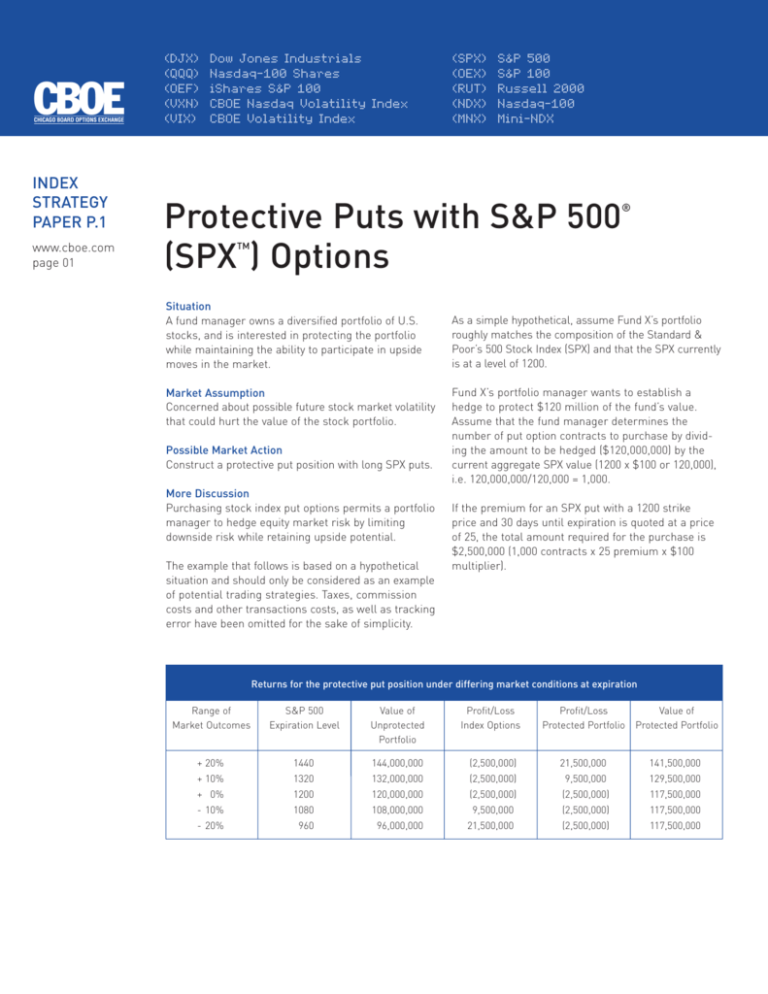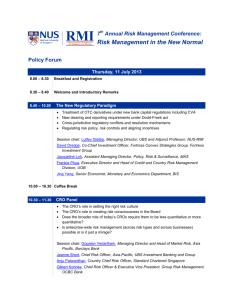
(DJX)
(QQQ)
(OEF)
(VXN)
(VIX)
INDEX
STRATEGY
PAPER P.1
www.cboe.com
page 01
Dow Jones Industrials
Nasdaq-100 Shares
iShares S&P 100
CBOE Nasdaq Volatility Index
CBOE Volatility Index
(SPX)
(OEX)
(RUT)
(NDX)
(MNX)
S&P 500
S&P 100
Russell 2000
Nasdaq-100
Mini-NDX
Protective Puts with S&P 500
(SPX ) Options
®
TM
Situation
A fund manager owns a diversified portfolio of U.S.
stocks, and is interested in protecting the portfolio
while maintaining the ability to participate in upside
moves in the market.
Market Assumption
Concerned about possible future stock market volatility
that could hurt the value of the stock portfolio.
Possible Market Action
Construct a protective put position with long SPX puts.
More Discussion
Purchasing stock index put options permits a portfolio
manager to hedge equity market risk by limiting
downside risk while retaining upside potential.
The example that follows is based on a hypothetical
situation and should only be considered as an example
of potential trading strategies. Taxes, commission
costs and other transactions costs, as well as tracking
error have been omitted for the sake of simplicity.
As a simple hypothetical, assume Fund X’s portfolio
roughly matches the composition of the Standard &
Poor’s 500 Stock Index (SPX) and that the SPX currently
is at a level of 1200.
Fund X’s portfolio manager wants to establish a
hedge to protect $120 million of the fund’s value.
Assume that the fund manager determines the
number of put option contracts to purchase by dividing the amount to be hedged ($120,000,000) by the
current aggregate SPX value (1200 x $100 or 120,000),
i.e. 120,000,000/120,000 = 1,000.
If the premium for an SPX put with a 1200 strike
price and 30 days until expiration is quoted at a price
of 25, the total amount required for the purchase is
$2,500,000 (1,000 contracts x 25 premium x $100
multiplier).
Returns for the protective put position under differing market conditions at expiration
Range of
Market Outcomes
S&P 500
Expiration Level
Value of
Unprotected
Portfolio
Profit/Loss
Index Options
Profit/Loss
Protected Portfolio
Value of
Protected Portfolio
+ 20%
1440
144,000,000
(2,500,000)
21,500,000
141,500,000
+ 10%
1320
132,000,000
(2,500,000)
9,500,000
129,500,000
+ 0%
1200
120,000,000
(2,500,000)
(2,500,000)
117,500,000
- 10%
1080
108,000,000
9,500,000
(2,500,000)
117,500,000
- 20%
960
96,000,000
21,500,000
(2,500,000)
117,500,000
(DJX)
(QQQ)
(OEF)
(VXN)
(VIX)
INDEX
STRATEGY
PAPER P.1
www.cboe.com
page 02
Dow Jones Industrials
Nasdaq-100 Shares
iShares S&P 100
CBOE Nasdaq Volatility Index
CBOE Volatility Index
(SPX)
(OEX)
(RUT)
(NDX)
(MNX)
S&P 500
S&P 100
Russell 2000
Nasdaq-100
Mini-NDX
Possible Outcomes
The Index Rises
At expiration, the puts have no value. However, in exchange for the cost of the puts (an insurance expense to
the portfolio), the fund manager achieved the goal of establishing a hedge for a portion of the portfolio and did
not incur the expenses of converting that portion of the assets to cash. Also, note that the portfolio retains any
dividends associated with holding the assets. Given the assumption of a correlation between the portfolio and
the index, the value of the portfolio increases.
The Index Falls
If the puts are at-the-money or in-the-money, an increase in the value of the puts may approximate the loss in
the portfolio’s value. Tracking error will undoubtedly have an effect on the actual losses in portfolio value if the
composition of the portfolio does not match the composition of the index. However, the protective puts limit the
portfolio’s downside, and the portfolio retains any dividends associated with holding the assets. If the index falls
but the puts remain out-of-the-money, the cost of the puts is an insurance expense to the portfolio.
The Index Remains Stable
The puts have little or no value at expiration, resulting in a loss of the premium, which can be considered an
insurance expense to the portfolio. This expense is, at least partially, offset by any dividends associated with
holding the assets. The value of the portfolio remains approximately the same.
The chart below graphs index value versus potential gain/loss. Note that a protective put strategy is a combination of long put options and stock.
Stock Portfolio with S&P 500 (SPX) Protective Puts
(At expiration)
Profit
Stock
Portfolio
Stock Portfolio
Hedged with
Protective Puts
0
Index Value
$2,500,000
Maximum Loss
Loss
1200 Protective Put Strike Price
If you would like to read more about protective strategies, please visit http://www.cboe.com/protection.
(DJX)
(QQQ)
(OEF)
(VXN)
(VIX)
INDEX
STRATEGY
PAPER P.1
www.cboe.com
page 03
Dow Jones Industrials
Nasdaq-100 Shares
iShares S&P 100
CBOE Nasdaq Volatility Index
CBOE Volatility Index
(SPX)
(OEX)
(RUT)
(NDX)
(MNX)
S&P 500
S&P 100
Russell 2000
Nasdaq-100
Mini-NDX
08.16.2001
Options involve risk and are not suitable for all investors. Prior to buying or selling options, a person must receive a copy of
Characteristics and Risks of Standardized Options, http://www.cboe.com which is available from The Options Clearing
Corporation, 440 S. LaSalle Street, 24th Floor, Chicago, IL 60605, or by calling 1.800.OPTIONS.
This discussion is designed to assist individuals in learning how options work and in understanding various options strategies.
This discussion is for educational purposes only and is not intended to provide investment advice. Commissions, taxes and
transaction costs generally are not included in this discussion, but can affect final outcome and should be considered. Please
contact a tax advisor for the tax implications involved in these strategies.
This discussion has been prepared solely for informational purposes, based upon information generally available to the public
from sources believed to be reliable, but no representation or warranty is given with respect to its accuracy or completeness.
No statement herein should be construed as a recommendation to buy or sell a security or to provide investment advice. Any
profit/loss diagrams refer only to approximate results at expiration. Past performance is no guarantee of future results. S&P
100® and S&P 500® are registered trademarks of the McGraw-Hill Companies, Inc., 0and are licensed for use by the Chicago
Board Options Exchange, Inc. (“CBOE”). The Russell 2000® Index is a registered trademark of Frank Russell Company. The
Nasdaq 100® is a registered mark of The Nasdaq Stock Market, Inc. “Dow JonesSM”, “Dow Jones Industrial AverageSM”, “Dow
Jones Transportation AverageSM,” and “Dow Jones Utility AverageSM” are service marks of Dow Jones & Company, Inc. and
have been licensed for certain purposes by the CBOE. iSharesSM is a service mark of Barclays Global Investors. The Goldman
Sachs Technology Indexes are the property of Goldman, Sachs & Co. and have been licensed to the CBOE in connection with
the trading of options based upon the indexes. Dow Jones & Co., The Nasdaq Stock Market, Goldman Sachs, and McGrawHill make no warranties and bear no liability in regard to the trading of index options. LEAPS®, FLEX®, FLexible EXchange®
and OEX® are registered trademarks and Long-term Equity AnticiPation SecuritiesTM and SPXTM are trademarks of the Chicago
Board Options Exchange, Inc. Copyright © Chicago Board Options Exchange, Inc. 2001.
All rights reserved.












